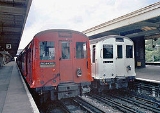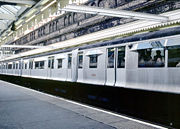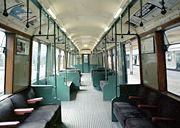
London Underground R Stock
Encyclopedia



District Line
The District line is a line of the London Underground, coloured green on the Tube map. It is a "sub-surface" line, running through the central area in shallow cut-and-cover tunnels. It is the busiest of the sub-surface lines. Out of the 60 stations served, 25 are underground...
in 1938, 1949, 1952 and 1959. R Stock cars were driving motors (DM) and non-driving motors (NDM). There were no unpowered trailers.
Construction
The R Stock was delivered in three batches, and each batch contained DM cars rebuilt from existing Q38 stockLondon Underground Q Stock
The Q Stock consisted of various District Line trains built from 1923 until the mid 1930s, originally built with manually operated sliding doors. Following conversion to air operated doors, the trains became collectively known as Q Stock...
trailers plus newly-built NDM cars; the second batch also included some new-build DM
.
- Stage I (225 cars):
- 82 DM (R38/1) converted 1948-51 by Gloucester RC&WGloucester Railway Carriage and Wagon CompanyGloucester Railway Carriage and Wagon Company was a railway rolling stock manufacturer based at Gloucester, England; from 1860 until 1986....
from Q38 trailers - 89 NDM (R47) built 1949-50 by Birmingham RC&WBirmingham Railway Carriage and Wagon CompanyThe Birmingham Railway Carriage and Wagon Company was a railway locomotive and carriage builder, founded in Birmingham, England and, for most of its existence, located at nearby Smethwick, with the factory was divided by the boundary between the two places...
- 54 NDM (R47) built 1949-50 by Gloucester RC&W
- 82 DM (R38/1) converted 1948-51 by Gloucester RC&W
- Stage II (133 cars):
- 43 DM (R38/2) converted 1951-3 by Gloucester RC&W from Q38 trailers
- 6 DM (R49) built 1952-3 by Metro CammellMetro CammellThe Metropolitan Cammell Carriage and Wagon Company was a Birmingham, England based manufacturer of railway carriages and wagons, based in Saltley and subsequently Washwood Heath....
- 84 NDM (R49) built 1952-3 by Metro Cammell
- Stage III (20 cars):
- 7 DM (R38/3) converted 1958-9 at Acton Works from Q38 trailers built
- 13 NDM (R59) built 1959 by Metro Cammell
The R38 cars were rebuilt from Q38 stock trailers which had been built by Gloucester RC&W in 1938-40, having been designed with such conversion in mind; the R47, R49, and R59 cars were built new. The R38 and R47 cars were built to a traditional steel
Steel
Steel is an alloy that consists mostly of iron and has a carbon content between 0.2% and 2.1% by weight, depending on the grade. Carbon is the most common alloying material for iron, but various other alloying elements are used, such as manganese, chromium, vanadium, and tungsten...
bodied design, whilst the R49 and R59 cars were largely of aluminium
Aluminium
Aluminium or aluminum is a silvery white member of the boron group of chemical elements. It has the symbol Al, and its atomic number is 13. It is not soluble in water under normal circumstances....
alloy. The R49 cars were the first built for London Underground
London Underground
The London Underground is a rapid transit system serving a large part of Greater London and some parts of Buckinghamshire, Hertfordshire and Essex in England...
with what for many years became the traditional unpainted aluminium finish, with the first train
Train
A train is a connected series of vehicles for rail transport that move along a track to transport cargo or passengers from one place to another place. The track usually consists of two rails, but might also be a monorail or maglev guideway.Propulsion for the train is provided by a separate...
entering service on 10 March 1952.
Formation
Cars were formed into semi-permanent units. When first placed in service, these were either four-car units with the cab at the west end (DM-NDM-NDM-NDM) or two-car units with the cab at the east end (NDM-DM); when all were in service, there were 51 four-car and 87 two-car units. For off-peak service, one unit of each type was coupled together to form a six-car train, whilst at peak times, several such trains would be lengthened to eight cars by the addition of a second two-car unit. A maximum of 36 eight-car trains could be formed, with the remaining 15 running as six-car.Description
Although visually similar the R Stock trains included some notable differences from the OLondon Underground O Stock
The O and P Stock was built for the Metropolitan Line and Hammersmith & City Line in 1937–1940 by Gloucester RC&W and Birmingham RC&W. In all there were 262 driving motors and 103 trailers...
, P and Q38 Stock trains. These included external 'door open' indicator lights, roller destination blinds, fluorescent lighting and a modified way of displaying the internal advertisements and District Line route maps.
One of the most noticeable design differences between the R38 Stock and the rest of the R Stock fleet was that the R38 cars featured four small windows in the central saloon between the double doors, whereas the R47, R49, and R59 cars featured just two larger windows in the same location.
All R Stock cars seated 40 passengers, however whilst the R38 cars featured two sets of transverse seats in the centre bay, the rest of the fleet featured just one set of transverse seats, and more longitudinal seating.
Modification
Initially the R Stock trains were painted red, to match the O, P and Q38 Stock trains, but one eight-car train of R49 stock was left unpainted, as an experiment. The R59 stock was also unpainted; the R38/3 stock that was converted to run with it was painted silver-grey to match. Since during the day the trains were regularly reformed between 6 and 8 cars (for peak / off-peak services) so it became normal to see trains of mixed red and silver formation. In 1963 the decision was taken to repaint all the red R Stock trains to match the unpainted aluminium cars, a process which was completed in 1968.In 1962/3 one train of R stock featured in early trials of automatically driven trains, prior to the larger scale trials on the Hainault
Hainault tube station
Hainault is a London Underground station on the Central Line in Hainault in the London Borough of Redbridge. Since 2 January 2007 the station is in Travelcard Zone 4. This station is home to one of the three Central Line depots.-History:...
- Woodford
Woodford tube station
Woodford is a London Underground station in Woodford in the London Borough of Redbridge, United Kingdom.The station is on the Central Line between South Woodford and Buckhurst Hill. The station is also a terminus for services via the Hainault loop....
section of the Central Line which preceded the full scale use on the Victoria Line
Victoria Line
The Victoria line is a deep-level London Underground line running from the south to the north-east of London. It is coloured light blue on the Tube map...
. These trials involved the one eastbound District Line train travelling in automatic mode between Stamford Brook
Stamford Brook tube station
Stamford Brook is a London Underground station on the eastern edge of Chiswick in west London. The station is served by the District Line and is between Ravenscourt Park and Turnham Green stations. The main entrance is located on Goldhawk Road with a secondary entrance on Prebend Gardens. It is in...
and Ravenscourt Park
Ravenscourt Park tube station
Ravenscourt Park is a London Underground station located in west Hammersmith, west London. The station is served by the District Line and is between Hammersmith and Stamford Brook stations....
stations.
In 1971 it was decided to abandon the practice of uncoupling on the District line, and that all District Line trains should henceforth be of seven cars. 36 of the four-car units were reduced to three cars; these units would in future always be coupled to two two-car units to form a seven car train. The remaining 15 four-car units were lengthened to five cars by adding one of the released cars; these units would work with a single two-car unit. This left 21 cars (all of R47 type) spare, which were sent for scrap.
Withdrawal and preservation
21 cars were withdrawn between October 1971 and February 1972 as a result of the reformation into 7-car trains. Several others were withdrawn between 1971 and 1982 due to fire damage. General withdrawal began in March 1981 and was completed in March 1983. At one point it was thought that the Athens-Piraeus Electric Railway would purchase 60 cars of R stock, for use in five-car trains, since the dimensions of that system were similar to the District Line. Modifications to the shoegear would have been required, because the Greek line was electrified at 550 V DC third-rail; but the deal fell through.They were replaced by the new D78 Stock
London Underground D78 Stock
The London Underground D Stock is a type of electric multiple unit used on the London Underground District Line . The entire fleet is due to be replaced with S Stock trains in 2015.- History :...
, except on the Edgware Road
Edgware Road tube station
Edgware Road station is a London Underground station on the corner of Chapel Street and Cabbell Street Road in Travelcard Zone 1 serving the Circle, District and Hammersmith & City lines. The separate Edgware Road tube station is about 150 metres away on the opposite side of the Marylebone Road...
-Wimbledon
Wimbledon station
Wimbledon station is a National Rail, London Underground, and Tramlink station located in Wimbledon in the London Borough of Merton, and is the only London station that provides an interchange between rail, Underground, and Tramlink services...
route, where shorter platforms necessitated the use of C Stock.
Three vehicles have been preserved.
- R38 DM no. 22624 - Mangapps Railway MuseumMangapps Railway MuseumThe Mangapps Railway Museum is a heritage railway located near Burnham-on-Crouch in Essex. The stretch of standard gauge track and museum are owned and operated by the Jolly family assisted by a dedicated staff of volunteers...
- R49 DM no. 21147 - Walthamstow Pump House MuseumWalthamstow Pump House MuseumThe Pump House Steam and Transport Museum is a museum in Walthamstow focusing on the pioneering achievements in road, rail, air and sea transport in the River Lea valley from the early 19th century...
- R49 DM no. 22679 - London Transport Museum, ActonActon, LondonActon is a district of west London, England, located in the London Borough of Ealing. It is situated west of Charing Cross.At the time of the 2001 census, Acton, comprising the wards of East Acton, Acton Central, South Acton and Southfield, had a population of 53,689 people...

